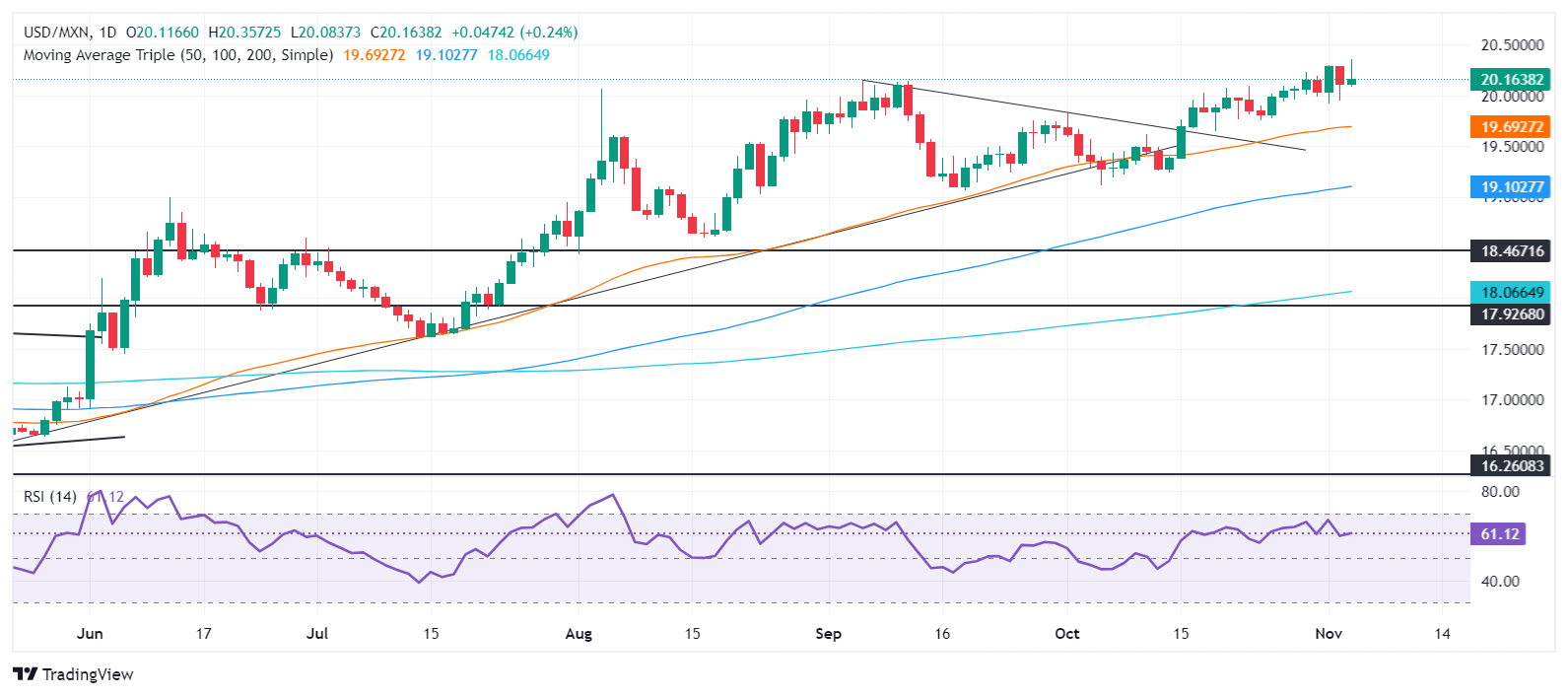- Mexican Peso pares losses against the US Dollar, as USD/MXN retreats below above 20.10 figure.
- Mexican Supreme Court debates judiciary reform amid rising domestic political tensions.
- US election in close race adds to Peso's depreciation as investors seek safe-haven assets.
The Mexican Peso has trimmed its earlier losses against the Greenback after posting a new record low on Tuesday as the US presidential election got underway. The Mexican Supreme Court began discussing Judge Juan Luis González Alcántara Carranca's proposal to modify the controversial judiciary reform presented by the ruling party Morena. At the same time, US business activity slowed, though it remains robust. The USD/MXN trades at 20.07, virtually unchanged.
Mexico’s economic docket is absent. Domestically speaking, investors focus on the Supreme Court decision amid an ongoing judicial crisis in the country.
Supreme Court Judge Juan Luis González Alcántara Carranca's proposal suggests that, “Contenders for the Supreme Court and other top courts would have to stand for election. But thousands of other judges, appointed based on years of training, would remain in their jobs,” via The New York Times.
President Claudia Sheinbaum refrained from discussing the court’s decision. During the same press conference, she responded to Republican candidate and former President Donald Trump about immigration, saying, “There will be a good relationship.” Sheinbaum added, “There has been a 75% decrease in migrants arriving at the northern border.”
Across the border, the US presidential election continues in a narrow race between Democratic Vice President Kamala Harris and Republican former president Trump. Trump’s campaign recognized that the election would likely not be called this afternoon, according to CNN, citing sources.
The US economic docket revealed that the Balance of Trade deficit widened, while business activity cooled slightly. S&P Global revealed that October’s service activity dipped, while the Institute for Supply Management’s (ISM) Services PMI improved for the same period.
USD/MXN traders await the Federal Reserve’s (Fed) monetary policy decision on November 6-7, in which the Fed is expected to lower borrowing costs by 25 bps. After that, Fed Chair Jerome Powell's press conference would be scrutinized by investors looking for cues on the Fed’s policy path.
Daily digest market movers: Mexican Peso consolidates on uncertainty scenario
- The USD/MXN remains adrift from political turmoil in Mexico after the approval of the controversial judiciary reform.
- Analysts see Mexico’s inflation moderating in October, according to Reuters.
- They project the Consumer Price Index (CPI) in October at 4.73% above the prior month’s 4.58% YoY. However, core CPI is expected to decrease for the 21 straight months to 3.85% from 3.91%.
- Former US President Donald Trump's harsh rhetoric weighs on the Peso. If Trump wins, a strong US Dollar could weigh on the Mexican currency, which could depreciate sharply due to threats to impose 25% tariffs on all products.
- The US Bureau of Economic Analysis revealed the US trade deficit widened in September to $-84.4 billion from a revised $-70.8 billion. Economists estimated the less widened deficit of $-84.1 billion.
- The US S&P Global Services PMI was 55.0 in October, below the forecast of 55.3 and September’s 55.2.
- The ISM Services PMI for the same period expanded to 56, from 54.9 in September, exceeding estimates of a deceleration to 53.8.
- The Federal Open Market Committee (FOMC) is expected to cut rates by 25 bps on November 7.
- Data from the Chicago Board of Trade, via the December fed funds rate futures contract, shows investors estimate 49 bps of Fed easing by the end of the year.
USD/MXN technical outlook: Mexican Peso trims some losses as USD/MXN drops below 20.10
The USD/MXN reached a new yearly peak of 20.35, yet the pair has retreated below 20.20 as recent polls showed Kamala Harris up in Nevada. Despite this, the uptrend remains intact, and a break above 20.35 could open the door to challenge the 20.50 figure ahead of September. 28, 2022, high at 20.57, and the August 2, 2022, peak at 20.82.
Conversely, if USD/MXN drops further, the first support would be the 20.00 figure. Once surpassed, the next stop would be the October 24 daily low of 19.74, ahead of the 50-day Simple Moving Average (SMA) at 19.66. Once those levels are surpassed, the next support would be the October 4 cycle low of 19.10.
Mexican Peso FAQs
The Mexican Peso (MXN) is the most traded currency among its Latin American peers. Its value is broadly determined by the performance of the Mexican economy, the country’s central bank’s policy, the amount of foreign investment in the country and even the levels of remittances sent by Mexicans who live abroad, particularly in the United States. Geopolitical trends can also move MXN: for example, the process of nearshoring – or the decision by some firms to relocate manufacturing capacity and supply chains closer to their home countries – is also seen as a catalyst for the Mexican currency as the country is considered a key manufacturing hub in the American continent. Another catalyst for MXN is Oil prices as Mexico is a key exporter of the commodity.
The main objective of Mexico’s central bank, also known as Banxico, is to maintain inflation at low and stable levels (at or close to its target of 3%, the midpoint in a tolerance band of between 2% and 4%). To this end, the bank sets an appropriate level of interest rates. When inflation is too high, Banxico will attempt to tame it by raising interest rates, making it more expensive for households and businesses to borrow money, thus cooling demand and the overall economy. Higher interest rates are generally positive for the Mexican Peso (MXN) as they lead to higher yields, making the country a more attractive place for investors. On the contrary, lower interest rates tend to weaken MXN.
Macroeconomic data releases are key to assess the state of the economy and can have an impact on the Mexican Peso (MXN) valuation. A strong Mexican economy, based on high economic growth, low unemployment and high confidence is good for MXN. Not only does it attract more foreign investment but it may encourage the Bank of Mexico (Banxico) to increase interest rates, particularly if this strength comes together with elevated inflation. However, if economic data is weak, MXN is likely to depreciate.
As an emerging-market currency, the Mexican Peso (MXN) tends to strive during risk-on periods, or when investors perceive that broader market risks are low and thus are eager to engage with investments that carry a higher risk. Conversely, MXN tends to weaken at times of market turbulence or economic uncertainty as investors tend to sell higher-risk assets and flee to the more-stable safe havens.
Information on these pages contains forward-looking statements that involve risks and uncertainties. Markets and instruments profiled on this page are for informational purposes only and should not in any way come across as a recommendation to buy or sell in these assets. You should do your own thorough research before making any investment decisions. FXStreet does not in any way guarantee that this information is free from mistakes, errors, or material misstatements. It also does not guarantee that this information is of a timely nature. Investing in Open Markets involves a great deal of risk, including the loss of all or a portion of your investment, as well as emotional distress. All risks, losses and costs associated with investing, including total loss of principal, are your responsibility. The views and opinions expressed in this article are those of the authors and do not necessarily reflect the official policy or position of FXStreet nor its advertisers. The author will not be held responsible for information that is found at the end of links posted on this page.
If not otherwise explicitly mentioned in the body of the article, at the time of writing, the author has no position in any stock mentioned in this article and no business relationship with any company mentioned. The author has not received compensation for writing this article, other than from FXStreet.
FXStreet and the author do not provide personalized recommendations. The author makes no representations as to the accuracy, completeness, or suitability of this information. FXStreet and the author will not be liable for any errors, omissions or any losses, injuries or damages arising from this information and its display or use. Errors and omissions excepted.
The author and FXStreet are not registered investment advisors and nothing in this article is intended to be investment advice.
Recommended content
Editors’ Picks

AUD/USD stays firm near 0.6300 after strong Chinese exports data
AUD/USD is trading well bid near 0.6300 in Asian trades on Monday, opening the week on the front foot. Risk sentiment remains in a sweeter spot following the weekend's news of lower US tariffs on Chinese electronic supply chain and strong Chinese exports data for March. Tariffs talks will remain on the radar.

USD/JPY recovers to 143.00 amid volatile trading
USD/JPY is trimming losses to retake 143.00 in Monday's Asian trading. The US Dollar pauses its latest leg down, with traders digesting Trump's tariff news from the weekend. However, the Fed-BoJ policy divergence expectations underpin the Japanese Yen, keeping the weight intact on the pair.

Gold record rally pauses on Trump’s tariff concession
Gold price builds on Friday’s pullback from record highs of $3,245 early Monday. Trump’s lower tariffs on Chinese electronics and chips offer relief to markets. Technically, Gold could see a brief correction before the next leg up.

Bitcoin is on the verge of a breakout while Ethereum and Ripple stabilize
Bitcoin price approaches its key resistance level at $85,000 on Monday; a breakout indicates a bullish trend ahead. Ethereum and Ripple found support around their key levels last week, suggesting a recovery is in the cards.

Is a recession looming?
Wall Street skyrockets after Trump announces tariff delay. But gains remain limited as Trade War with China continues. Recession odds have eased, but investors remain fearful. The worst may not be over, deeper market wounds still possible.

The Best brokers to trade EUR/USD
SPONSORED Discover the top brokers for trading EUR/USD in 2025. Our list features brokers with competitive spreads, fast execution, and powerful platforms. Whether you're a beginner or an expert, find the right partner to navigate the dynamic Forex market.



